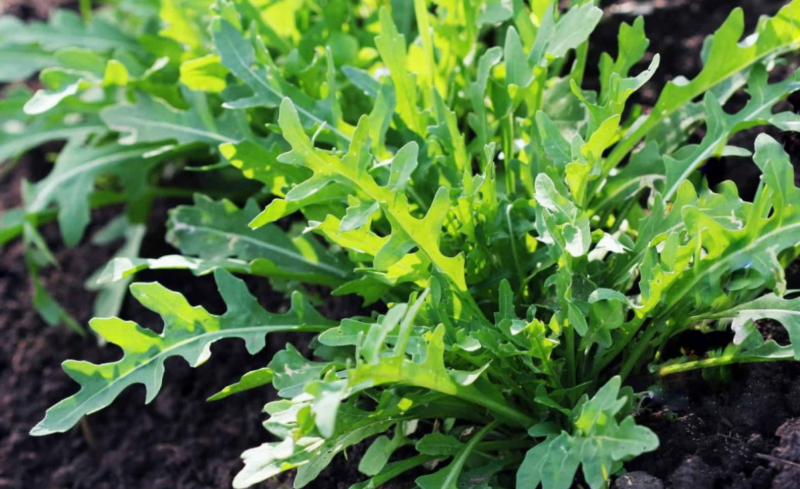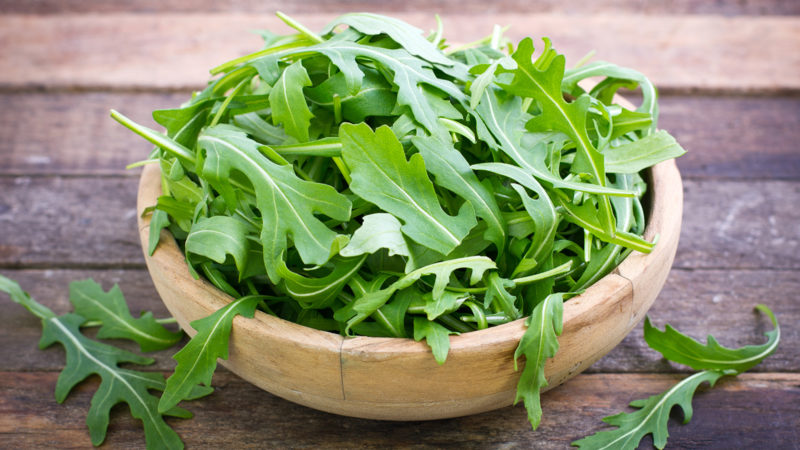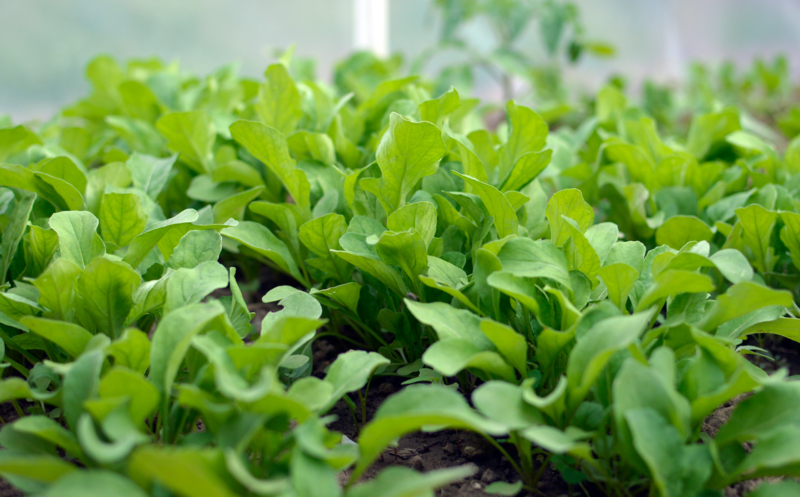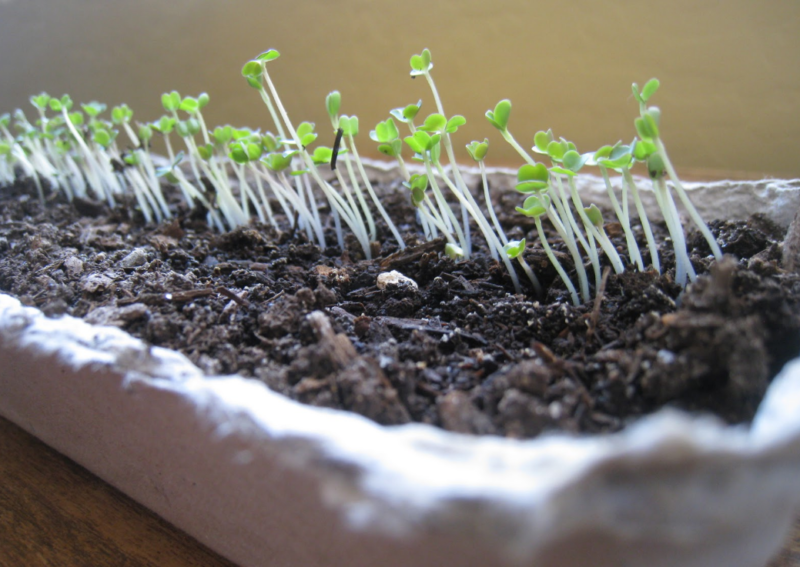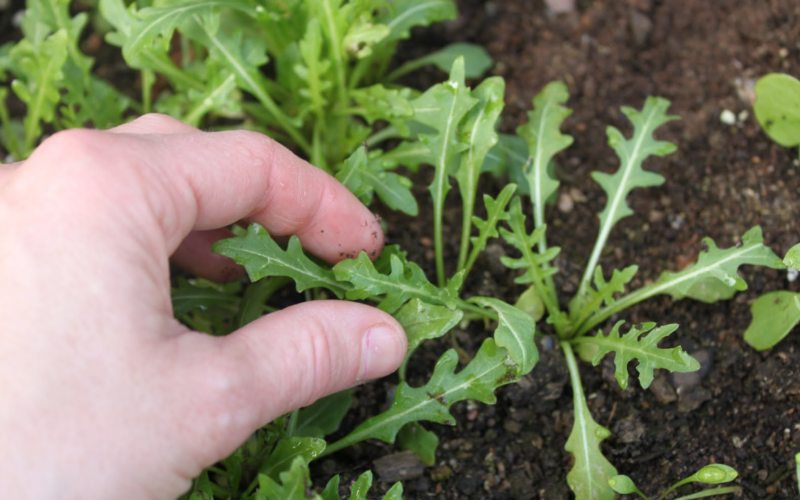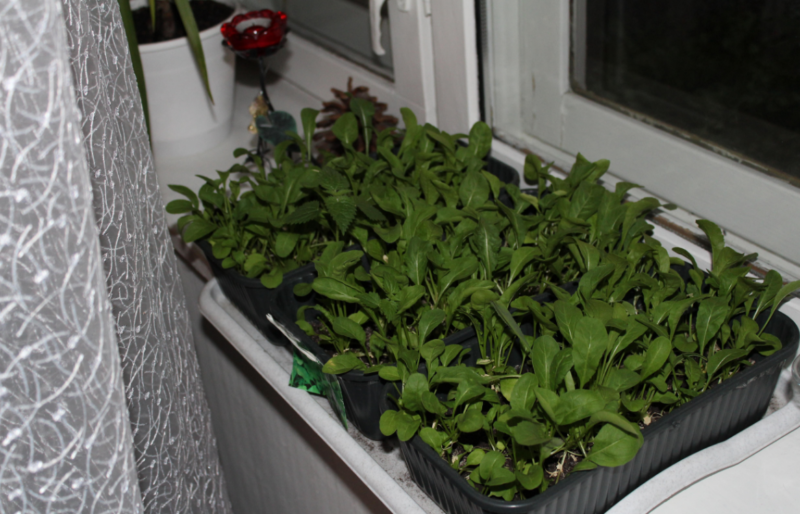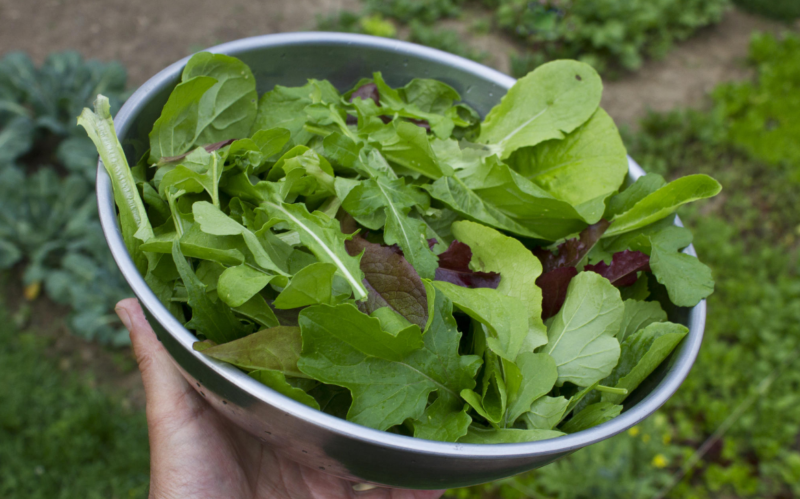For a long time on the territory of our country, arugula was considered weed grass, it was ruthlessly pulled out from the beds and sent to compost. At this time, Italian cooks already knew that the plant is a delicious addition to many dishes. Today, our people have discovered this grass, and in almost every suburban area it can be found in the garden. Today we will talk about what arugula is, about its benefits and harms, and also share the secrets of growing this plant in our garden and even on the windowsill.
Material Content:
What is arugula
Arugula has many names. This is a caterpillar, and Eruka, and Indow. Arugula belongs to cruciferous plants, and this family is famous for its beneficial properties.
Arugula fell in love for its spicy, moderately pungent taste, which will brighten up any dish. For the most part, the grass grows in the countries of the Middle East, but today it spreads rapidly throughout the world, it is used to prepare many dishes, mainly used as an additive to vegetable salads.
Arugula - a godsend for everyone who decided to lose weight.
This salad, like no other, has a huge amount of substances that have a lasting positive effect on metabolic processes in the body. And the plant is a natural energetic. The composition of the grass contains a high content of iodine and vitamin C, so after using arugula in food, people feel a surge of strength. Also, the composition has a beneficial effect on the withdrawal of cholesterol from the blood, increases hemoglobin.
Arugula is an aphrodisiac plant. Many centuries ago, love potions were created from it.To cook one today, you need to consume one teaspoon in the morning from a mixture of 100 g of dry grass with a tablespoon of honey and the same amount of black pepper!
These are far from all the properties of arugula; more can be learned about it further. But is the plant so safe for the body?
Health benefits and harms
Arugula foliage is more than decorating salads, soups and main dishes. Among the components of this plant there are many vitamins (including B9 and A), trace elements (calcium, iron, potassium, iodine, magnesium, flavonoids).
Bioactive components of the herb have a beneficial effect on the immune system, restore the water-salt balance, and help reduce blood sugar.
More about the benefits of greenery:
- Arugula can prevent the development of gastric ulcer. Scientists from America have proved that eating arugula as a treatment for gastritis is safer than using medications. But in the treatment it is impossible to rely only on the leaves of this plant, they are used as an auxiliary component in general therapy.
- The arugula benefits in the prevention of oncology.
- The plant improves digestion, has a diuretic effect on the body (widely used by people suffering from puffiness).
- Chewing the leaves of arugula, you can prevent the development of scurvy and even cure it.
- The plant is an excellent antimicrobial and antibacterial product that can overcome cough.
- Substances contained in the grass strengthen blood vessels.
- The juice from the plant is used by traditional healers to get rid of polyps, treat bruises and skin ulcers.
- The seeds of arugula are many essential oils, it is mostly mustard oil. The plant is also rich in acids (erucic, linoleic, oleic, linolenic and so on).
To get all the benefits of the plant, it is enough to add its leaves to vegetable salads, soups and side dishes.
As far as harm is concerned, arugula is an almost harmless plant.
The only thing is that it can cause allergies. Arugula is contraindicated in people with individual intolerance, in moderate amounts it can be used by patients with gastritis. For pregnant women, the plant has no contraindications, but since it is an allergen, it should be used with caution.
Popular types and varieties
Arugula perennial and annual - a popular type of salad in the whole world. On the windows of horticultural stores there are many different varieties of this plant.
Consider the most popular of them:
- "Wonderland" (2010 selection) is a low plant, the upright stalk, slightly lowered down, reaches a length of 18-20 cm. It blooms with small flowers of cream color. The shape of the leaves is lyre-shaped, the surface is smooth. The variety perfectly tolerates cold, therefore it is widespread in countries with a cool and harsh climate. The plant retains flavoring qualities for a long time, it releases the arrow late. Leaves are harvested 30-35 days after the appearance of the first sprouts.
- "Cupid's Arrows" (2011 selection) - stem height from 20 to 30 cm, foliage long and thin, with wavy edges. Light yellow flowers. Also, like the previous variety, it shoots up late, you can collect leaves for food after 35 days from the appearance of sprouts.
- "Poker" (cultivated variety since 2005) is one of the most popular varieties. Appreciated for its taste, it is excellently suited both for salad supplements and for use as a full-fledged garnish for fish and meat dishes. An early-ripening variety, it is recommended to collect grass on the 20th day after the emergence of seedlings. The height of the bush is from 40 to 80 cm.
- "Sicily" (variety bred in 2006) - collection - for 20-27 days. Appreciated for its unique nutty flavor and strong aroma. Plant height - up to 60 cm, tolerates frosts up to -6 degrees, but does not respond well to heat. It blooms with white flowers, decorated with streaks of purple.
- "Rococo" (2006) - the variety attracts the attention of culinary experts with a pronounced aroma and taste with a speck.Harvesting plants - 20-25 days after hatching seeds, the height of the bush is up to 25 cm. The foliage is wide, the edges are slightly jagged.
- "Corsica" (2006) - mid-season variety, harvest - for 30 days. Plant height - up to 65 cm. There is a big minus - quickly releases the arrow, so you need to have time to harvest.
- “Coltivata” (a young variety bred in Holland in 2015) is a taste in nutty mustard notes and strong aroma. Height - up to 25 cm, collection - on 25-27 days from the appearance of seedlings. The foliage is dissected, very juicy.
- "Spartak" (2012) - an early ripening variety, the leaves are ready for use in food after 25 days. Plant height - up to 70 cm, foliage is smooth, resembles a sorrel in shape.
- "Victoria" (2012) - mid-season variety, harvested on days 28 and 35. Height - up to 70 cm, spicy taste.
- “Rocket” (2006) - collection - on day 28, height can reach 60 cm. Very strong aroma from greens, mustard taste, moderately sharp.
- "Solitaire" (variety 2007) - ripens on the 25th day, height - up to 20 cm. Winter hardiness is high, you can leave it in the open ground until spring, and get early shoots in spring!
- "Euphoria" (2007) - height - up to 25 cm, ripening - on 30-35 days. The variety tolerates cold, heat and drought.
- “Olivetta” (2011) - the variety is ready for collection for 20-25 days, height - up to 30 cm. Pungent taste and strong aroma. This variety is also called wild arugula, since it was really found in nature and almost did not change. A cultivated plant has more advantages: juiciness, winter hardiness, more pronounced aroma and taste.
It is impossible to list all varieties of arugula in one article, there are a lot of them. To this day, new ones continue to appear. Feel free to choose seeds from the prescribed varieties: they are high-yielding, excellent in taste and useful properties.
When to plant and how to care in the open ground
Planting on the beds can be done more than once per season.
Sowing seeds usually begin in April-May (depending on the region), and for the last crop sown in mid-August. To grow from seeds, you need to wait for optimal weather conditions: the earth should warm up to +15 degrees, and the average daily temperature should reach at least +5. Some varieties are resistant to frost, but it is better not to subject the plant to such tests.
The first planting in the spring is recommended to be done in the seedling method from mid-May to mid-June. Two weeks before the intended planting, sow the seeds at home in boxes with soil.
And this is done like this:
- Pour the earth in pots or in drawers; a universal garden one will do.
- Make grooves with a depth of not more than 0.5 cm, sow the seeds. It is better to use tweezers, as the seed is very small. If the landing turned out to be thickened, then during the transplant, divide the bushes and plant them as needed.
- Sprinkle seeds, water from a watering can or spray soil from a spray bottle.
- Cover the boxes with polyethylene so that the seeds sprout faster.
After about a week, the first leaves will appear. After another week, seedlings can be planted on beds.
Do not forget to water the plantings in pots and crates: the soil must be stably moist.
Now you need to choose the optimal place for planting the arugula, because not in every section it will grow equally well. The bed should be in a well-lit sun. Some varieties tolerate shade, but in such conditions there will be no rich harvest! The plant grows well in areas where tomatoes, potatoes, carrots, legumes and pumpkin were previously planted. Avoid places where radish and cabbage grew.
Still need to pay attention to the pH of the soil. Arugula simply will not grow in the acidified area: it prefers neutral or slightly acidic soil. For deoxidation, you can add dolomite flour, lime or ash to the ground. Dig it up.
Planting seedlings:
- Water the seedlings in pots, so you do less damage to the roots. Remove the bushes from the container.
- Prepare the holes, the distance between which should be at least 10 cm, and between the rows - 30 cm or more.
- Arugula, along with an earthen lump, must be pitted, dug, and watered.
- Although the plant is frost-resistant, it is weakened after transplantation. Night frosts may suddenly come on, so cover the first 2-3 days after transplanting the arugula with plastic bottles or plastic wrap overnight. Do not forget to open it in the morning, otherwise the daytime sun will burn the foliage.
- Sowing seeds
- Prepare the beds, make grooves with a depth of 5 mm.
- Using tweezers, spread the seeds along the grooves with a distance of 15 cm from each other. Keep a distance of 35 cm between rows. The values are greater than when planting seedlings, as a bulky bush will grow from a small seed. As a result, we keep within the 10/30 standards.
- Pour the drip plantings (watering can or spray).
- If thickening occurs during planting, sprout seedlings when 3 true leaves appear.
Caring for a plant is quite simple, but it needs to be given special attention, because without your help, the arugula will die or grow weak.
Produce watering based on the condition of the earth, it must constantly be moistened. It is ideal to irrigate in the evening. You need to do this work once every two days, and in the hot summer every evening.
Since the soil will be stably moist, it will begin to compact, and the roots will not receive the right amount of oxygen. Each time after watering, you need to loosen the ground between the rows with a wooden stick or small rakes. Clean weed immediately: it takes a lot of nutrients from cultivated plants.
Arugula can only be fed with ash. The fact is that the leaves of this plant absorb everything that enters the soil. This also applies to harmful compounds present in fertilizers of chemical origin.
Growing at home
By planting arugula at home, you will not only make the room more comfortable and beautiful, but also get a healthy salad supplement. You can plant bushes in any container. The main thing is that the depth should be at least 10 cm.
The soil is suitable universal garden or one that is designed for growing vegetable seedlings. Pour boiling water over the soil, so you kill possible bacteria.
Landing:
- Lay crushed stone at the bottom of the pot; it will serve as a drainage. Fill the containers with earth, make a hole 1-1.5 cm deep, plant the seed. If growing in boxes, then make furrows with a distance of 15 cm. Leave 10 cm between the seeds.
- Pour the soil, cover with foil, remove to heat. Stabilize soil moisture and water if necessary. As the shoots appear, remove the film.
Care:
- Water the plant every other day: the ground should be moist. With a lack of water, the foliage will be bitter.
- It is recommended to grow arugula on the windowsill on the south side, as the plant is photophilous. The temperature for growth has a wide range and varies from +7 to +25 degrees.
- Each time after watering, loosen the soil around the plant.
In this way, you can grow arugula every year, and it will be at hand in the kitchen at any time. No need to go to the country for greens!
Arugula Diseases and Pests
The juice of the plant contains a lot of essential oils, so it scares off most pests by itself.
But still, the arugula is attacked by some insects and diseases.
Disease
- Fusariosis is a disease that cannot be treated. Sick plants need to be removed, and the soil after them treated with fungicides or manganese. Signs of Fusarium: yellowing of leaves, dark roots and stems.
- Peronosporosis is also an incurable disease. Remove the ruccola from the garden. Symptoms of the disease: black spots on the green.
Pests:
- Fleas. These small insects can completely exterminate the arugula, and make the remaining plantations unfit for human consumption. Malicious insects devour foliage, leaving many holes on it.To combat, use a powder on the soil in the form of red pepper or ash.
- Cabbage moth loves to enjoy this plant. If one is wound up, spray the ruccola with wormwood infusion. You can also insist on tops of potatoes.
Infusion is simple to do:
- Narva tops or wormwood, fill the bucket completely.
- Fill with water, remember.
- Let it brew for 3 days, spray the plants.
To protect plantings from pests, immediately after planting seedlings and when seedlings appear, sprinkle ash on the ground.
Harvesting greens
When describing the varieties, we talked about how long it is possible to harvest.
This is the most optimal plant age when it has accumulated the maximum amount of nutrients.
If collected earlier, the taste of greens will not be so pronounced, so you should wait for the right time.
After the arugula fires an arrow and blooms, the leaves are not harvested either. The greens begin to get bitter and become hard and dry - no pleasure!
When growing arugula at home, it is recommended to harvest when the foliage reaches a size of 10 cm. Do not wait for a larger size, at home the plant will quickly fire an arrow.
When the flowering is over, seeds will appear, they can be carefully collected and dried to make decoctions in the winter, add to the soup. Get a unique antiviral, antimicrobial agent. Apply decoctions for coughing: sputum will depart faster.
It would seem that some plant that complements the salad. But arugula is a real natural first-aid kit, a storehouse of vitamins, minerals and essential oils. Eat arugula throughout the summer season, and in winter plant it in pots on the windowsill. Many ailments will bypass you. And also about the benefits of arugula on the windowsill: it is a disinfectant (thanks to essential oils), which, like geranium, will kill pathogenic microbes in the air of the apartment! Health to you and your loved ones!


